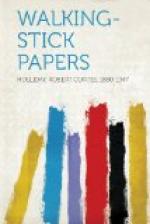From his carriage, moving slowly in on the arm of a Japanese boy, his servant, came one day John La Farge. Tales of the Far East. Profound erudition, skin of sear parchment, Indian philosophies, exotic culture, incalculable age, inscrutable wisdom, intellectual mystery, a dignity deep in its appeal to the imagination—such was the connotation of this presence. (Fine as that portrait by Mr. Cortissoz.) An Oriental scholar, all right, we thought. Mr. La Farge was in search of some abstruse art books. He did not care, he said, what language they were in, except German. He said he hated German. “Well, we have to go to the German for many things, you know,” we said. “Yes,” said Mr. La Farge, “we have to die, too, but I don’t want to any sooner than I can help.”
But it is not famous authors only that are interesting. We were approached one day by a tall, exceedingly solemn individual who asked for a copy of a book the name of which sounded to us like the title of what “the trade” knows as “a juvenile.” “Who wrote it?” we inquired, puzzled. In a deep, hollow voice the unknown gentleman vibrated, “I did.”
A very light-coloured new Norfolk suit, with a high hat; an exceedingly neat black cutaway coat and handsome checked trowsers, a decidedly big derby hat (flat on top), an English walking coat, with plaid trowsers to match, the whole about a dozen checks high. This? An inventory of the wardrobe of Dr. Henry van Dyke, as it has been displayed to our appreciation. Has not the handsome wardrobe been a familiar feature in the history of literature? And does anybody like Dr. Goldsmith the less for having loved a lovely coat?
A slight figure, very erect and alert. A dapper, dignified step. Movement precise. An effect of a good deal of nose glasses. Black, heavy rims. A wide, black tape. Head perpendicular, drawn back against the neck. Grave, scholarly face, chiselled with much refinement of technique; foil to the studious complexion, a dark, silken moustache. Holding our thumb-nail sketch up to the light, we see it thus.
We regret that our view of this figure so prominent in our literature is perforce so entirely external. But for this Dr. van Dyke has no one to blame but himself, his fastidiousness in clerks. Ignoring, as he passes, our offer of service, at the desk where he seats himself he removes his hat—a large head, we note, for the figure, a good deal of back as well as top head—and, preparing to write, to fill out the order forms himself, fumbles a great deal with his glasses, taking off and putting on again. A friend discovering him here, he springs up and greets him with much vivacity. His orders written out, he delivers them into the hands of the manager of the shop with whom he chats a bit. . . .




